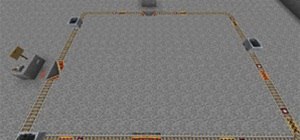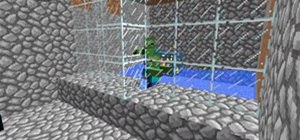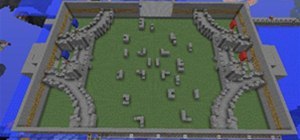Introduction
So today and yesterday I was playing with TNT (as we all do at one point or another) and I was curious about a few things. From this curiosity, I went on to discover some of the science behind some things you may or may not have known.
While I was conducting this study, I also realized I had no idea on the physics of a minecraft player. I knew gravity existed in the world, but had no idea at what speed it acted. This also broadened my scope to include items as well.
While I could have included water and Lava as well, they did not strike me as things needing a lot of proof. I may do some science toward them and other blocks in future.
Please NOTE b/s = Blocks per second
PLAYERS and Gravity: The Facts
This is a summary of all of the facts determined in these tests. If you wish to check the method of acquisition you may scroll down to see it below.
1 Block = 1 Meter or 1.09 Yards (This is a well known point)
Players take 0.058 seconds to fall from a block
Players fall at 13 b/s^2
If players fall and die at 24 blocks, it takes roughly 1.2 seconds to hit the ground and they hit at 21.8 b/s^-1 with an acceleration of 22.48b/s^2
PLAYERS and GRAVITY - Obtaining the Facts
Yes, as you are no doubt aware, gravity is in force in Minecraft! In this test it was proven the observable fact that fall speed in Minecraft is not a constant variable, but a matter of acceleration over time. I sought to discover what the pace of minecraft gravity was and how it related to a player.
We all know that the maximum fall distance for a player is 23.5 blocks, provided they don't use the gravel/sand trick or fall into water. Falling from this distance leaves the player with half a heart of health remaining out of 10.
This is a given to most of you, but let's figure out the speed of travel.
To figure this out, I fell from a number of different heights repeatedly and recorded the time taken to fall from each point.
After falling from 90 blocks in the air a number of times, the averaged time was registered at 2.57 seconds.
Falling 70 Blocks yielded a time average of 2.25 seconds, 50 Blocks, 1.85 seconds, 30 blocks at 1.36 seconds, and 10 blocks at 0.52 seconds.
Now that I had average times, I was able to work out the speed of travel at each point.
In physics, the Velocity of an object is determined with v=s/t. V obviously for Velocity, S for Distance, and T for Time.
In the first example, that left me with the right amount of information to easily work out the science behind it and based on my study, this is what I came to!
The base acceleration of a player falling is 13b/s^-2, which was determined by noting a pattern in the fall rate at each point measured. The speed coming from 90 blocks was just over double the speed measured for a player dropping 1 block.
This is when the acceleration could be measured! A pattern was discovered and this, now included in the basic facts above, was determined to be at 1 block per second per second (not stuttering here :P) every 5 blocks.
Full list of all (averaged) recorded facts are as follows
90 Blocks - 35b/s^-1 - 2.57s
70 Blocks - 31b/s^-1 - 2.25s
50 Blocks - 27b/s^-1 - 1.85s
30 Blocks - 23b/s^-1 - 1.36s
24 Blocks - 21.8b/s^-1 - 1.25s
10 Blocks - 19b/s^-1 - 0.52s - Had to be determined by math
01 Blocks - 17b/s^-1 - 0.058s - Had to be determined by math
TNT and Gravity: The Facts
TNT will explode after 4 seconds (40 ticks)
TNT will fall for a total of 73 Blocks before exploding (see video)
The Velocity of TNT prior to exploding is 18.25b/s^-1
See video for more scientific facts about TNT.
The calculated acceleration based on the velocity on impact is 4.56b/s^2
ITEMS and Gravity: The Facts
Items despawn after exactly 5 minutes (Obvious man is obvious!)
Blocks drop at an acceleration rate of approximately 8.5 b/s^2
ITEMS and GRAVITY - Obtaining the Facts
It was no small chore figuring out how quick blocks fell and it is possible my calculations are off on this one slightly. I used a lot of math based on my observations and fraps video and inspect the video on a frame by frame basis to attempt to capture it as best I could. I came up with a lot of random, but similar numbers, but 8.5 was the only one that linked everything.
I am not completely happy that this is absolute, but it was as best I could do without seeing the code itself. The others were a lot easier to work with given that TNT had an established round off explosion time.
To record this, three blocks were dropped from different heights and averages were deducted from the three heights. A quick recap of the findings of 10, 20, and 30 block drops are as follows:
Drop from 10 blocks - 1.176s - 8.75b/s^-1
Drop from 20 blocks - 1.19s - 10.115b/s^-1
Drop from 30 blocks - 1.27s - 11.05b/s^-1
Across the board, based on a lot of headache like math (due to the diversity in the recordings), we finally got there and while I am not entirely convinced, it's a number that has been put on paper to be disproved later.
Just updated your iPhone? You'll find new emoji, enhanced security, podcast transcripts, Apple Cash virtual numbers, and other useful features. There are even new additions hidden within Safari. Find out what's new and changed on your iPhone with the iOS 17.4 update.























Be the First to Comment
Share Your Thoughts